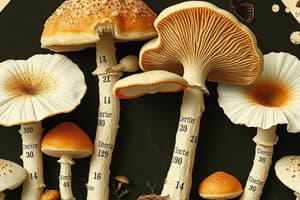Podcast
Questions and Answers
Apa yang menjadi ciri khas dari Zygomycota?
Apa yang menjadi ciri khas dari Zygomycota?
Bagaimana Ascomycota biasanya bereproduksi?
Bagaimana Ascomycota biasanya bereproduksi?
Dimana umumnya Basidiomycota ditemukan?
Dimana umumnya Basidiomycota ditemukan?
Apa yang menjadi ciri umum dari semua jenis fungi?
Apa yang menjadi ciri umum dari semua jenis fungi?
Bagaimana Basidiomycota umumnya mereproduksi secara seksual?
Bagaimana Basidiomycota umumnya mereproduksi secara seksual?
Apa karakteristik hifa dari kelompok fungi deuteromycota?
Apa karakteristik hifa dari kelompok fungi deuteromycota?
Kelompok jamur deuteromycota bereproduksi secara aseksual melalui apa?
Kelompok jamur deuteromycota bereproduksi secara aseksual melalui apa?
Apa yang menjadi ciri khas Ascomycota dalam reproduksi seksual?
Apa yang menjadi ciri khas Ascomycota dalam reproduksi seksual?
Dimana biasanya Zygomycota ditemukan?
Dimana biasanya Zygomycota ditemukan?
Bagaimana Ascomycota biasanya mereproduksi secara aseksual?
Bagaimana Ascomycota biasanya mereproduksi secara aseksual?
Flashcards are hidden until you start studying
Study Notes
- Sekolah materi ketiga bab fungi, di bab sebelumnya sudah membahas ciri umum fungi dan cara hidup fungi.
- Fungi dapat diklasifikasikan berdasarkan struktur hifa (jaringan rambut tipis panjang, berwarna putih) dan alat berkembangbiaknya.
- Fungi dikelompokkan ke empat kelompok: zygomycota, ascomycota, deuteromycota, dan basidiomycota.
- Zygomycota adalah jenis fungi yang bereproduksi secara seksual dan hifa nya adalah Hipa aseptat (hifa tanpa sekat). Umumnya berukuran mikroskopik dan tidak terlihat mata manusia.
- Zygomycota umumnya ditemukan pada roti yang telah berjamur atau pada benda membusuk di tanah (contohnya jamur tempe).
- Zygomycota bisa bereproduksi secara seksual (menggunakan organ reproduksi zigosporangium, menghasilkan zigospora) atau aseksual (menggunakan sporangium, menghasilkan zigospora).
- Ascomycota adalah kelompok fungi terbesar, dapat bereproduksi secara seksual (menghasilkan askospora dari askos) atau aseksual (menghasilkan konidiospora).
- Ascomycota umumnya dapat bereproduksi secara seksual menggunakan sitoplasma atau plasmogami, menghasilkan hifa dikariotik, dan meiosis menghasilkan banyak askospora.
- Basidiomycota adalah kelompok fungi terbesar kedua, dapat bereproduksi secara seksual (menghasilkan basidiospora dari basidium) atau aseksual (pilkan konidiospora).
- Basidiomycota umumnya dapat mereproduksi seksual melalui peleburan sitoplasma atau plasmogami, menghasilkan hifa dikariotik, meiosis menghasilkan banyak basidiospora haploid, dan hifa haploid ini bisa tumbuh pada kondisi sesuai.
- Kelompok fungi deuteromycota, memiliki hifa yang bersifat asetat atau hifa tanpa sekat. Kelompok jamur ini masih belum jelas.
- Kelompok jamur deuteromycota bereproduksi secara aseksual melalui konidiospora, namun proses reproduksi secara seksual belum pasti.
- Fungi dikelompokkan ke dalam kelompok dengan unsur yang berbeda, yaitu dilihat dari jenis ipa-nya dan juga alat reproduksinya.
Translated into English:
- The third topic in the biology of fungi class, in the previous topic, we had discussed the common characteristics of fungi and their way of life.
- Fungi can be classified based on the structure of hifa (thin, long, white strands that form the body of fungi) and the reproductive organs.
- Fungi are classified into four main groups: zygomycota, ascomycota, deuteromycota, and basidiomycota.
- Zygomycota is a type of fungi that reproduces sexually and has aseptate hifas (hifas without septa). They are usually microscopic and not visible to the human eye.
- Zygomycota are commonly found in rotten or moldy bread or soil (such as tempe mushroom).
- Zygomycota can reproduce sexually by using a zigosporangium organ, producing zigospora, or asexually by producing sporangium, also producing zigospora.
- Ascomycota is the largest group of fungi, can reproduce sexually by producing ascospores from asci or sacs, and asexually by producing conidiospores.
- Ascomycota usually reproduce sexually by fusing hyphae through plasmogamy, producing diploid hifas, and undergoing meiosis, resulting in many ascospores.
- Basidiomycota is the second largest group of fungi, can reproduce sexually by producing basidiospores from basidia and asexually by producing conidiospores.
- Basidiomycota usually reproduce sexually through plasmogamy, producing diploid hifas, undergoing meiosis, and producing many basidiospores. The haploid basidiospores can grow under suitable conditions.
- Deuteromycota is a group of fungi with asetate hifas or hifas without septa. The classification and sexual reproduction of this group of fungi are still unclear.
- Deuteromycota reproduce asexually by producing conidiospores, but the sexual reproduction is not yet clear for all species of this group.
- Fungi are classified into groups based on their unique characteristics, namely their ipas and reproductive organs.
Studying That Suits You
Use AI to generate personalized quizzes and flashcards to suit your learning preferences.




